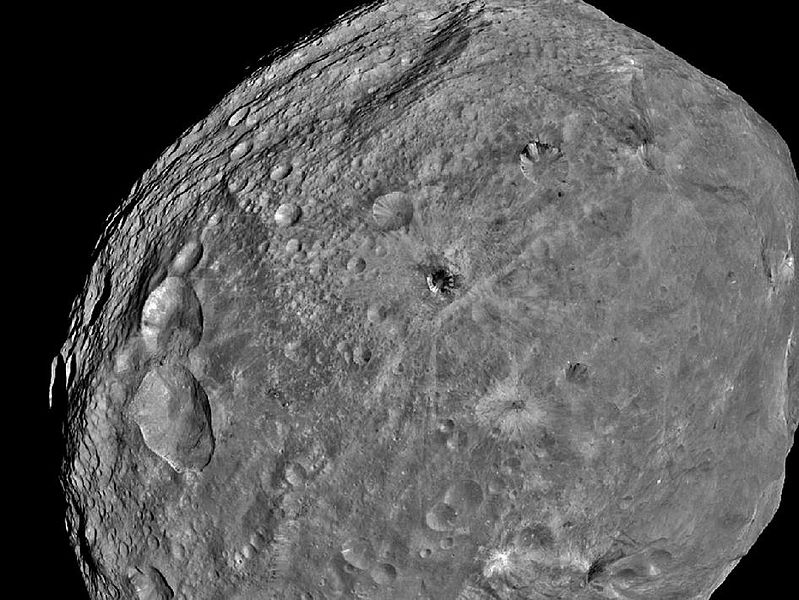We're open daily! View holiday hours
Science News
The Vesta Mission
May 14, 2012
by Alyssa Keimach

What can a good-sized asteroid (330 miles across) tell us about the formation of our solar system and planet? A lot, if that asteroid is Vesta.
Launched in September 2007, the Dawn spacecraft mission marked the first prolonged visit to the main asteroid belt, entering Vesta’s orbit last July. The second largest and brightest asteroid in the asteroid belt, Vesta has a surface marked by basaltic flows, which have long sparked astronomers’ interest. Dawn’s discoveries have confirmed scientists’ suspicions that Vesta is an intriguing place…
Dawn’s mission includes collecting data from both high- and low-altitude orbits around Vesta—a recent NASA video shows simulated flights around the asteroid based on current imagery. With a press conference and series of papers in the journal Science last week, NASA marked the end of Dawn’s low-altitude orbit. The spacecraft will move to a high-altitude orbit of the northern hemisphere this summer when the area is more lit by sunlight, likely resulting in many more findings. Dawn will leave Vesta on August 26th and head to the neighboring dwarf planet, Ceres.
The new studies reveal that, for an asteroid, Vesta is very planet-like, possessing an Earth-like internal structure. Dawn is equipped to measure slight changes in the gravitational pull on the spacecraft, which allows astronomers to explore the internal structure of Vesta—it seems to have an iron core underneath its mantle and crust, similar to Earth. Together with information about surface temperatures and composition, these findings suggest that Vesta is a protoplanet—a planet whose full development failed due to a small mass.
For Vesta to have developed its iron core, it must have been extremely hot during the early history of the Solar System, some 4.56 billion years ago. To explore this hypothesis, astronomers used data from the Framing Camera and the Visible and Infrared Mapping Spectrometer. The Framing Camera found evidence that Vesta once possessed a subsurface magma ocean, which could have existed only if the asteroid was extremely hot. The asteroid has chilled off quite a bit since then—now Vesta has temperatures between –10° and –150° Fahrenheit, depending on the amount of sunshine.
The Dawn mission has also explored the ages of two large impacts on the southern hemisphere: the newest crater on the southern hemisphere of Vesta dates to a mere one million years ago, and the older of the two is about twice as old. The freshness and brightness of these recently-produced craters allow astronomers to extrapolate more about the Solar System’s history.
“The large impact basins on the Moon are all quite old,” says David O’Brien, a Dawn participating scientist from the Planetary Science Institute. “The fact that the largest impact on Vesta is so young was surprising.”
Some of the meteorites found on Earth contain traces of pyroxene, a material rich in iron and magnesium. This resembles the material on Vesta, confirming earlier theories that many Earth-bound meteorites originated from Vesta. The Dawn mission confirms that 6% of Earth’s meteorites came from Vesta, which puts Vesta at the top of the list for the largest contributor to Earth’s meteorite impacts.
An infographic of Dawn’s mission can be found at Space.com.
Alyssa Keimach is an astronomy and astrophysics student at the University of Michigan and volunteers for the Morrison Planetarium.